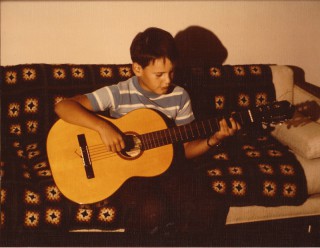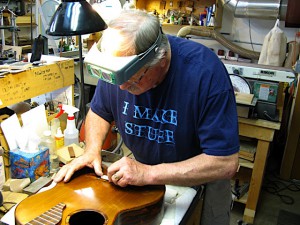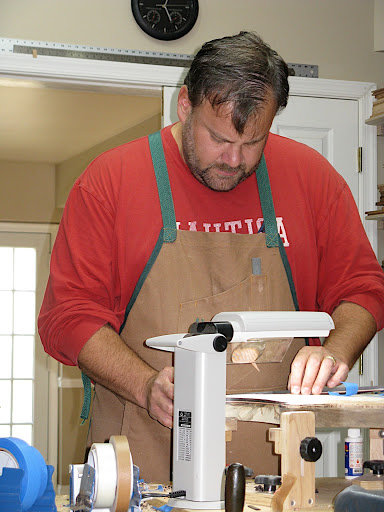About the Luthier
The Early Years …
I began my musical journey at age 9. My uncle Marcello, an excellent guitarist, had just visited from Italy. As my favorite relative, I very much wanted to play guitar just like him. Marcello gave me $20 as he prepared to leave Virginia for Italy. With another $5 in savings, I purchased a classical guitar. My parents paid for lessons, an expense I now realize was significant for our family at that time.

Filippo playing classical guitar
I studied classical guitar for several years. Fortunate enough to have my father frequently take me to the Kennedy Center, I was blessed with the opportunity to meet several great guitarist, including Andrés Segovia, Julian Bream and Christopher Parkening.
In my early teens I began playing bluegrass, learning to flat pick standards. I spent hours playing along with records, or with my father or at bluegrass jams. Doc Watson and Chet Atkins were my favorite guitarists. In my late teens I organized a 15 or so piece jazz band and played bass. I also began writing music for acoustic fingerstyle guitar, often in alternate tunings in the spirit of Will Ackerman and Alex De Grassi.
At an early age I had a fascination for taking things apart. By mid teens I started having enough follow through to actually create instead of disassemble! My teen years were spent making custom rifles, muzzleloaders, gunstocks and grips. At age 16 I took a job building a Victorian home—the owner, father-in-law and myself—a big job for two men and a teenager. During college I worked as an apprentice to a master craftsman. In my twenties I programmed computers, from robots to early analytics systems. From my mid twenties to mid thirties I frequently worked in an automotive road racing shop where I was involved in building race cars and performing restorations, learning practical engineering, fabrication, construction and finish.
Luthiery Mentors …
Innovation always looks easy from the perspective of imitation.

Randy Reynolds fitting a saddle on a Reynolds Concert Grand – a Kasha braced Western Red Cedar double top classical guitar.
Fast forward to my mid thirties. I met a friend of my father in Colorado Springs—Master Luthier, Randy Reynolds. My father had just received an instrument commissioned with Randy. I was stunned at the guitar’s tonal qualities. Upon meeting Randy and visiting his shop I had an epiphany. Like most, I was used to seeing guitars hanging on a wall: a finished product. It was so obvious in hindsight but such a discovery in the moment—the character of handcrafted instruments came alive with visits to Reynolds Guitars—a harmonization of craft and music. Through Randy’s tutelage and friendship I began the journey into luthiery. I’ve been hooked ever since. Reynolds guitars are world class in my book, especially the classical guitars. Randy is also one of the early pioneers of the double top guitar.
I don’t know that one can teach intuition, but from Randy I learned how to think about how sound is created, how to feel it in my hands and shape it from an instrument. One really can’t put that in a book. My ways and mannerisms around wood are largely attributed to his philosophy. If I thought for one moment that all this intuition and feel was poppycock, the error of my thinking could lead me astray. But Sharon Isbin continues to invite Randy to spend the week as the master luthier at her Aspen, Colorado master class, so if I’ve lost my mind I’m in good company.
I’ve also had the good fortune to work with luthier Todd Stock at Greenridge Guitars, probably the most exceptional artisan I’ve ever met. Double down a tremendous gift for teaching. With Todd I saw how engineering and process are tantamount to building an excellent finished instrument. His workmanship is superb, as is his understanding of composition and design language. With a focus on steel string instruments with strong traditional roots, Todd is chased by a backlog of orders along with a list of existing Greenridge Guitar owners awaiting second instruments.
In addition building guitars Todd performs significant repair work, including many vintage instruments as well as regular everyday guitars. Repair is its own discipline and one must understand how to consider an instrument, its circumstances and decide the best course of action for the instrument and its owner. There are few excellent repair luthiers and I now know why. Working a couple days a week in the shop at Greenridge Guitars earned an understanding of repair, restoration and setup. I’m not sure this level of expertise can be learned in the classroom.
Finally I’ve had the pleasure of working alongside Chris Verhoeven of Raygun Engineering. Chris is a gifted luthier with significant experience building electric guitars. He also studied and worked for David Myka, whose guitars are world renowned. While all guitars are ultimately acoustic to me, electric guitar design and construction is significantly different than acoustic guitars. Chris’ influence and willingness to share his experience and knowledge are second to none in the craft.
My Luthiery Today … Creating for the Musician
As you will see throughout the site, I work on a broad range of guitars in construction, setup, repair and restoration. My goal is simple—to create instruments that exceed the expectations of my clients. I have been stunned to discover that many luthiers either do not know how to play the guitar, play with little proficiency and are not well trained in method and technique. I was equally surprised that many of them could nonetheless build great guitars!

Filippo Morelli binds an electric guitar body.
As a near 50 year player, my extensive background playing the guitar intrinsically feeds my intuition as I create instruments. My first priority is to spend time with a client and understand what is important to them in their music—be it style, how they play, where they play, what moves them in their music and their guitar. To build a special instrument—one where the client develops an intimate and long lasting relationship—is my sole focus. Achieving this marriage between musician and instrument is high art form and my ultimate goal as a luthier.
I place a tremendous emphasis on sonoral qualities—the instrument must sing, but it must sing with a voice that speaks to its player in its purposes. A fingerstyle guitarist may desire a well balanced instrument with prominent bass, crisp and well balanced mids, and strong trebles with tonal complexity. A classical guitarist may desire a highly responsive guitar—one with dynamic range and fast response, or a sweeter tone amenable to Spanish romance. Equally I place great focus on the playability of an instrument. No matter how great an instrument may sound, if it does not play with grace and ease it only stands the chance to permanently damage the player’s hand and forearm. A stiff playing guitar, no matter how sweet sounding or great looking, becomes a miserable beast that sits in the case while other instruments are favored.
I view playability in three fundamental dimensions. First the left hand at the neck. This is where we touch the guitar and have the greatest physical intimacy with the instrument. Many small design details culled from years of making necks separate Morelli guitar necks from others. Second, the setup of the instrument. Every detail of a setup, including a few thousandths of action height, can make a profound difference in a guitar’s playability. Frequently instruments come into the repair shop having been set up by a previous luthier. They often leave with a more precise setup which the client immediately notices. Finally, the shape of the instrument can impact posture whether playing seated or standing. I work closely with clients to determine the most effective body shape both for the desired sound as well as the desired playing style. Many small details, even in the body, can make a significant difference to the playability of the final instrument.
Please feel free to peruse the site to get a sense of my work, style and end product. I am always happy to meet new players, especially curious ones, including a visit to my instrument room and shop. I hope you find a few things you like and consider my instruments or services in helping you create great music!

